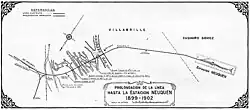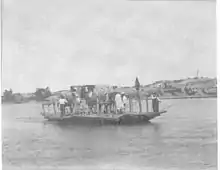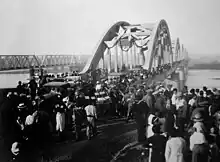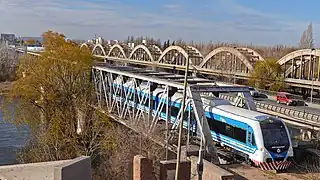Neuquén–Cipolletti bridges
The Neuquén-Cipolletti bridges are a series of four bridges that connect the cities of Neuquén and Cipolletti by spanning the Neuquén River, in Argentina. Three parallel ones, two road bridges and a railway bridge, were built on a former herd wrangling path. The fourth one was built upstream.
By 1899 the expansion of the Buenos Aires Great Southern Railway reached the station that later would become Cipolletti. To continue to the Neuquén Territory, a steel railway bridge was constructed in 1899–1902 to cross the Neuquén River. After the railroad connected Neuquén Station on the Confluencia settlement, the capital of the Territory was moved to the area, and the city of Neuquén founded in 1904.
Vehicular and pedestrian crossings of the river were made using boats and canoes at that time. By the 1930s, the service was overwhelmed by the growing population. The first road bridge opened 1937, while new road bridges opened in 1997 and 2017.
Background

In 1896, due to territorial disputes with Chile, the Argentinian Government commissioned the British-owned company Buenos Aires Great Southern Railway (Spanish: Ferrocarril Sud) to expand the existing railroad tracks from the city of Bahía Blanca, in the Buenos Aires Province, to the Neuquén National Territory. The expansion of the railroad was aimed at facilitating the quick transport of troops and supplies to the Chilean border in case of war.[1] A previous contract proposal by the Southern Railway was rejected in 1895 by the Argentinian Charmber of Deputies, as the company desired to lay tracks until General Roca, Río Negro or the confluence of the Limay and Neuquén rivers to avoid building a bridge on the site of the current city of Neuquén. The Chamber of Deputies felt that the construction of a railway bridge was necessary to guarantee the movement of Argentinian troops to the rest of the region in case the river flooded.[2] By that time, the capital of the Neuquén National Territory was located in the city of Chos Malal. The journey between the city of Buenos Aires and the capital of the Territory lasted fifteen days, while the mail service arrived once a month.[3]
On August 31, 1899, the expansion of the railroad reached the station Km. 1,190 (later renamed Limay Station).[4] The contract for the expansion, signed on March 16, 1896, established that the corporation F.C. Sud was to build a railroad bridge over the Neuquén River to continue the expansion of the tracks to the Neuquén National Territory.[5] Across the river, the isolated Confluencia settlement was formed by Spanish and Italian immigrants. Living in a sparse group of houses, the settlers' economy was sustained by the agriculture, while they depended on boat and canoe services to cross the river and remain communicated with the rest of the country.[6]
Railway bridge

The construction of the railway bridge was assigned to engineer Karl Krag. Due to several floods of the river during the tests of the ground, Krag decided to build the bridge 100 meters upstream from the original planned point, on the margin of the river that was used as a cross by herd wranglers. An island located in the middle of the river was used to build the columns of the bridge while the water was low.[7]
Krag arrived in September 1899 to survey the area to find the most suitable location to build the bridge. The findings of Krag were reported to the London consultants Livesey & Henderson that projected the construction of a structure of seven spans, each 52.2 metres (171 ft) long; and a 352-metre (1,155 ft) wooden trestle approach viaduct.[8] The steel sections, nuts, bolts and rivets were sent from Birmingham, United Kingdom. Unsuitable to be used for the abutment and foundations, the local rock and sand was replaced by material brought from Pichi Mahuida. A tide gauge was placed in Paso de los Indios, one of the headwaters of the Neuquén River to measure the changes on the water level. The telegraph office at Paso de los Indios would update mornings and nights the workers with the level of water expected at construction site within 24 to 30 hours. A second tide gaude at Chos Malal would alert the site 60 hours ahead of time.[9] During the construction, the workers camped in tents on the left bank, while during the summer they moved to nearby bulrush shacks.[10] The process marked the first use in Argentina of compressed air in construction, implemented to build the foundations with caissons.[11] A general store that received supplies from Ingeniero White twice a week was established for the workers to buy wares at low prices, while a cargo depot had to be built close to the construction site.[9]

The construction of the bridge was interrupted by three floods that destroyed tracks and makeshift bridges and interrupted traffic.[12] On July 12, 1900, a telegraph message from Paso de los Indios warned the construction site of an upcoming major flood of the river. The initial report indicated that the waters raised 1.7 metres (5.6 ft), while an update the next morning showed 6 metres (20 ft) and raising. The staff was then ordered to move everything from the construction site to safety at Limay Station only leaving behind provisory bridges and tracks. Two boats and a speedboat, all steam powered, were ordered to remain on the southern bank and to maintain constant pressure day and night. By 8 PM, the station at Paso de los Indios registered a height of 8 metres (26 ft) to 9 metres (30 ft). After the waters raised to 3.5 metres (11 ft) by 10 PM at the construction site, all work was interrupted.[13] The highest part of the construction, two cylinders that held the airlock were visible due to a wave that rose above them.[12] Five men on a shack who refused to move to higher ground needed to be rescued, as well as some of the workers of the general store. Two rescue trips by one of the small boats were successful, while during the third trip it capsized throwing all three of the rescued men to the waters. The workers reached the roof of the shack where they were previously trapped, and they were later rescued by the powerboat.[14]
The construction works were soon resumed, and by June 26, 1901, the completed bridge was load tested. On July 12, 1902, it was officially opened for traffic. The first passing locomotive, number 205, was operated by engineer Antonio Mazzarolo, accompanied by fireman Francesco Della Negra.[15] Neuquén Station was built on the other side of the river, on the rural Confluencia settlement.[16] The same year, a resolution of the territorial disputes with Chile was negotiated with British intervention.[17] By 1904, Governor Buquet Roldán decided to move the capital of the Neuquén Territory from Chos Malal to the Confluencia settlement, and founded Neuquén City. The move was leveraged by the railroad, that shortened travel time between the Territory and Buenos Aires to a maximum of three days.[16]
Gallery
 Bridge under construction, 1901
Bridge under construction, 1901 Advanced construction, late 1901
Advanced construction, late 1901 Construction near its end, 1902
Construction near its end, 1902 Men posing in front of the bridge soon after its opening
Men posing in front of the bridge soon after its opening Postcard depicting the bridge
Postcard depicting the bridge.jpg.webp) View of the bridge from its deck
View of the bridge from its deck Side view of the bridge
Side view of the bridge
Old road bridge

Following the opening of the railway bridge, pedestrian cross was facilitated by the new structure, while boats and canoes still constituted the main crossing for pedestrian and vehicle transportation.[18] As the population grew, by the 1930s the boat services became insufficient. After several complaints and stories published in the local press, Governor Carlos H. Rodríguez requested of the National Directorate of Roadways (Spanish: Dirección Nacional de Vialidad) the construction of a road bridge.[19] The structure was to be built next to the railway bridge, in the cross of the former herd wrangling path. The construction was assigned to the German-owned company GEOPÉ.[18] The cornerstone was laid on May 26, 1935, by the new governor, Enrique Raimundo Pilotto. The construction deadline was set for April 15, 1937.[19]

The structure was formed by nine spans of 51.6 metres (169 ft), united with 6 metres (20 ft)-wide concrete tied arches. Two 1 metre (3.3 ft) sidewalks were built on each side with 1 metre (3.3 ft) guard rails. The abutment was built over four-armed concrete cylinders that reached a depth of 12 metres (39 ft) under the soil of the river. Each of the eight columns of the bridge were founded over two-armed concrete cylinders, with the depth of 12 metres (39 ft). The road was 6 metres (20 ft) wide, while the bridge had a height of 15 metres (49 ft). On Neuquén's side, 55 cubic metres (1,900 cu ft) of land were removed to create a ten-metre wide roadway. The total cost of the works, and compensations for expropriations amounted to ARS$920,700.[20]
By February 1937, the works initially directed by engineer Poenitz, and later continued by Lettner were finished two months ahead of schedule. Businessman Otto Max Neumann organized the opening ceremony. On February 20, 1937, the bridge was inaugurated by Governor of Neuquén Enrique Raimundo Pilotto and Cipolletti citizen Augusto Mengelle, who represented the absent Governor of Rio Negro. Two thousand citizens attended the opening, while a caravan of 300 cars crossed the bridge, following the car of Neuquén's Governor.[18]
Gallery
 The road bridge under construction
The road bridge under construction Construction site of the bridge, 1936
Construction site of the bridge, 1936 Inauguration, 1937
Inauguration, 1937 View of the road bridge and the railway bridge
View of the road bridge and the railway bridge Side view of the bridge
Side view of the bridge
Second and third road bridges
By the 1980s, as traffic grew, the two-way old bridge became insufficient for the traffic demand. Jams and saturation of the roads during the rush hour led the National Directorate of Roadways to include in its 1987 construction plans a new bridge, to be built parallel to the old bridge. Raúl Martínez, the president of the Directorate, visited the area to negotiate an agreement between the cities of Cipolletti and Neuquén. Both cities were unable to reach a mutual consensus on the location of the bridge, causing the National Directorate of Roadways to drop the project. In 1992, the two cities reached an agreement: to build a new road bridge between the existing one and the railroad bridge. The deal included the construction of toll booths for the new and old bridges, operated by the private company Caminos Del Valle S.A. The profits would be allocated to the finance of the construction of a third bridge upstream, to further alleviate traffic congestion.[21] The project reconfigured part of the National Route 22, making a couplet of the two bridges, with the old bridge being limited to eastbound traffic (from Neuquén towards Cipolletti) and the new one limited to westbound traffic (from Cipolletti towards Neuquén). Construction works on the second road bridge started in 1995,[22] and the structure opened to traffic in 1997.[23]
By that time, Caminos del Valle failed to construct the third bridge, citing governmental bureaucratic reasons. The construction of the third bridge started in 2002, with the site located upstream from the three existing bridges. The structure measured 250 metres (820 ft) long and 10 metres (33 ft) wide.[23] 32 hectares (79 acres) of land were expropriated from eleven owners, including apple producer Moño Azul S.A. The construction cost was estimated at ARS$6 million,[24] and the bridge was completed in 2007.[25] In 2013, the toll booths were removed as the contract of Caminos del Valle expired.[26] The National Directorate of Roadways continued the works on the third bridge, and announced the opening for 2015.[27]
The third bridge opened in October 2017. The ceremony was attended by Argentina's president, Mauricio Macri, the governors of the Neuquén and Rio Negro Provinces Omar Gutiérrez and Alberto Weretilneck respectively, and transport minister Guillermo Dietrich among other officials.[28] The structure opened without the finished interchanges intended to merge traffic more safely from the provincial route 7 from Neuquén city and Centenario towards Cipolletti, as well as the northern highway (Autovía Norte) to connect Plottier.[29] The local representative of the Transport Department attributed the lack of the interchanges to the "societal pressure" to open the third bridge,[30] while he noted the need for a fourth bridge.[29] By 2020, the provinces of Neuquén and Rio Negro moved all truck traffic to the third bridge while a ban for their use of the first two bridges was banned.[31] the following year, further works on the interchanges continued and more lighting was added.[32]
Notable events

In March 1997, a series of demonstrations by education trade unions took place in the Neuquén Province. The Argentine Confederation of Education Workers (CTERA –; Spanish: Confederación de Trabajadores de la Educación de la República Argentina) blocked the road bridges.[33] By disrupting traffic, the blockade affected product supply to the city of Neuquén. At the time, the city produced ten percent of its consumed products, while the rest was transported to it in trucks. The 2,000-protester sitdown strike was broken on March 28, by a force of 300 men of the Provincial police and National Gendarmerie. Protesters were dispersed with tear gas and rubber bullets, with a toll of six wounded.[34] Reacting to the incidents, CTERA launched a 24-hour national strike.[35] Following the original block, throughout the years several protests in Neuquén city mirrored the act.[36]
The use of the railway bridge was included in the route of the Tren del Valle, the reactivation of the inter-city passenger services. A cracked column of the bridge, which previously had a makeshift pallet reinforcement was repaired.[37] The test of the bridge and tracks was performed on July 9, while the official opening of the line that initially will connect Neuquén and Cipoletti is planned for July 20.[38]
References
- Gómez Fuentealba 1992, p. 182.
- Raone, Mario 2004.
- Barba 1981, p. 356.
- Gómez Fuentealba 1992, p. 216.
- Barba 1981, p. 119.
- Bandieri, Favaro & Morinelli 1993, p. 273.
- Rögind 1937, p. 250.
- Rögind 1937, p. 251.
- Rögind 1937, p. 252.
- Barba 1981, p. 120.
- de Paula, Gutiérrez & Viñuales 1981, p. 121.
- Mendiberri et al. 2013, p. 20.
- Rögind 1937, p. 253.
- Rögind 1937, p. 254.
- Edelman 1991, p. 27.
- Mendiberri et al. 2013, p. 21.
- Masés 1994, p. 4.
- Morando 2007.
- LM Neuquén Staff 2004.
- Neumann 1954, p. 4.
- Zambon 2010.
- Argentinian Chamber of Deputies 1995, p. 3852.
- Rio Negro staff 2003.
- Bilardo 2002.
- LM Nequén staff 2014.
- Rio Negro staff 2013.
- Diariamente Neuquén staff 2014.
- Neuquén informa 2017.
- Rio Negro staff 2018a.
- Rio Negro staff 2018b.
- Rio Negro staff 2020.
- Rio Negro staff 2021.
- Petruccelli 2005, pp. 165–166.
- DyN 1997.
- Petruccelli 2005, p. 167.
- Armesto 2005, pp. 119–120.
- LM Neuquén staff 2015.
- Ministerio del Interior 2015.
- Sources
- Argentinian Chamber of Deputies (1995). Trámite parlamentario [Parliamentary procedure] (in Spanish). Imprenta del Congreso de la Nación.
- Armesto, Melchor (2005). "La productiva introducción del espacio en el análisis de las confrontaciones políticas. Apuntes sobre el movimiento de desocupados en la Argentina reciente" [The Benefits of Introducing Spatial Dimensions in the Analysis of Political Contention. Notes on the Unemployed Workers' Movement in Argentina]. Política y sociedad (in Spanish). Universidad Complutense de Madrid. 42 (5). ISSN 1130-8001.
- Bandieri, Susana; Favaro, Orietta; Morinelli, Marta (1993). Historia de Neuquén [History of Neuquén] (in Spanish). Plus Ultra. ISBN 978-9-502-11092-9.
- Barba, Enrique (1981). Quinto Congreso Nacional y Regional de Historia Argentina: celebrado en Resistencia y Corrientes del 1 al 5 de septiembre de 1981 [Fifth National and Regional Congress of Argentine History: Celebrated in Resistencia and Corrientes on September 1–5, 1981] (in Spanish). Vol. 1. Academia Nacional de Historia.
- Bilardo, Gerardo (2002). "Construyen un puente que se hizo esperar" [A long-awaited bridge is under construction]. La Nación (in Spanish). SA La Nación.
- de Paula, Alberto; Gutiérrez, Ramón; Viñuales, Graciela María (1981). Influencia alemana en la arquitectura argentina [German influence in Argentine architecture] (in Spanish). Departamento de Historia de la Arquitectura, Universidad Nacional del Nordeste.
- Diariamente Neuquén staff (2014). "Prometen habilitar tercer puente (en un año más)" [Inauguration of the third bridge promised (one more year)]. Diariamente Neuquén (in Spanish). Abrelatas SRL. Archived from the original on 2014-11-01.
- DyN (1997). "CTERA podira lanzar otro paro nacional" [CTERA could launch another national strike]. La Nación (in Spanish). SA La Nación.
- Edelman, Ángel (1991). Primera historia del Neuquén: recuerdos territorianos [Early history of Neuquén: Territorial memories] (in Spanish). Plus Ultra. ISBN 978-9-502-11017-2.
- Gómez Fuentealba, Rául (1992). Una Provincia llamada Neuquén [A Province Named Neuquén] (in Spanish). Editorial A–Z. ISBN 978-9-505-34183-2.
- LM Neuquén Staff (2004). "Asado para todos, en el día de la inauguración del puente carretero" [Barbecue for everybody, on the road bridge's inauguration day]. LM Neuquén (in Spanish). La Mañana Neuquén.
- LM Nequén staff (2014). "Tercer puente y autovía, las claves" [Third bridge, highway and the keys]. LM Neuquén (in Spanish). La Mañana Neuquén.
- LM Neuquén staff (May 19, 2015). "Empezaron las obras para que pase el Tren del Valle" [The works for the run of the Tren del Valle were initiated]. LM Neuquén. La Mañana Neuquén.
- Masés, Enrique (1994). El mundo del trabajo: Neuquén, 1884–1930 [The World of Work: Neuquén, 1884-1930] (in Spanish). G. E. Hi. So. ISBN 978-9-879-98160-3.
- Mendiberri, Héctor Antonio; Soufal, Federico Francisco; Moreno, Rodolfo Lauro; Giordano, Héctor (2013). Petróleo y Colonización [Oil and Colonization] (in Spanish). Editorial Dunken. ISBN 978-9-870-26812-3.
- Ministerio del Interior (July 10, 2015). "Finalizaron las primeras pruebas del tren 0Km que unirá Neuquén y Cipolletti" [The tests of the new train that will connect Neuquén and Cipolletti were performed]. Prensa Argentina (in Spanish). Secretaría de Comunicación Pública. Archived from the original on August 10, 2015. Retrieved July 13, 2015.
- Morando, Héctor Pérez (2007). "Cumple 70 Años El Puente Que cruzo el Río Neuquén" [The Bridge That Crossed the Neuquén River Turned 70]. Rio Negro (in Spanish). Editorial Rio Negro S.A.
- Neumann, Otto Max (1954). Álbum de los 50 años de Neuquén [Neuquén's 50-Year Album] (in Spanish). OM.
- Neuquén informa (October 6, 2017). "Se inauguró el tercer puente entre Neuquén y Cipolletti" [The third bridge between Neuquén and Cipolletti is inaugurated]. Gobierno de la Provincia del Neuquén (in Spanish). Retrieved July 24, 2023.
- Petruccelli, Ariel (2005). Docentes y Piqueteros: De la Huelga de ATEN a la Pueblada de Cutral Có [Teachers and picketers: From the ATEN strike to the Cutral-Có riot] (in Spanish). El Cielo por Asalto. ISBN 978-9-879-03529-0.
- Raone, Mario (March 10, 2004). "La verdadera historia de la construcción del puente ferroviario" [The truth story behind the construction of the railway bridge]. La Mañana Neuquén (in Spanish). Retrieved July 19, 2023.
- Rio Negro staff (2003). "El Tercer Puente Ya Tiene Sus Pilotes en el Rio" [The third bridge already has its columns on the river]. Rio Negro (in Spanish). Editorial Rio Negro S.A.
- Rio Negro staff (2013). "Luego de 16 años levantan el peaje en los puentes Cipolletti-Neuquén" [After 16 years the toll on the Cipolletti-Neuquén bridges is removed]. Rio Negro (in Spanish). Nuevo Tiempo Rio Negro.
- Rio Negro staff (February 5, 2018b). "Habilitaron el Tercer Puente sin rulos por "presión de la sociedad"" [The third bridge opened without interchangers due to "societal pressure"]. Rio Negro (in Spanish). Retrieved July 19, 2023.
- Rio Negro staff (October 29, 2018a). "Los "rulos" para conectar el tercer puente de Neuquén no avanzan" [The interchanges to connect the third bridge do not advance]. Rio Negro (in Spanish). Retrieved July 19, 2023.
- Rio Negro staff (June 16, 2020). "Video: el tránsito en el Tercer Puente desde un drone" [Video: transit through the third bridge seen from a drone]. Rio Negro (in Spanish). Retrieved July 24, 2023.
- Rio Negro staff (February 15, 2021). "Recta final para las obras paralizadas del Tercer Puente en Neuquén" [Finish line for the frozen construction works at the third bridge in Neuquén]. Rio Negro (in Spanish). Retrieved July 24, 2023.
- Rögind, William (1937). Historia del Ferrocarril Sud [History of the Southern Railway] (in Spanish). Establecimiento Gráfico Argentino, S. A. Retrieved July 18, 2023 – via Google Books.

- Zambon, Humberto (2010). "La licitacion del corredor 29" [The Commission of roadway 29]. LM Neuquén (in Spanish). La Mañana Neuquén.
External links
 Media related to Neuquén-Cipolletti Bridges at Wikimedia Commons
Media related to Neuquén-Cipolletti Bridges at Wikimedia Commons